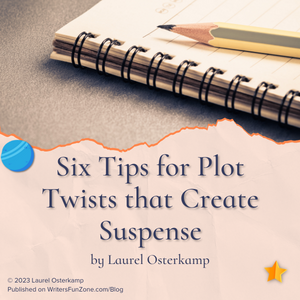Six Tips for Plot Twists that Create Suspense by Laurel Osterkamp
 Let’s welcome back Laurel Osterkamp as she shares with us “Six Tips for Plot Twists that Create Suspense.” Enjoy!
Let’s welcome back Laurel Osterkamp as she shares with us “Six Tips for Plot Twists that Create Suspense.” Enjoy!
***
Who doesn’t love good plot twists?
They’re a great way to keep readers guessing and engaged with a story. They can surprise, delight, and shock readers and give them a new perspective on the plot. Truly great plot twists are unexpected and logical, yet still exciting.
But what about bad plot twists? Hmm.
Bad plot twists are the black sheep of popular fiction. They feel forced and contrived. Bad plot twists just don’t fit in.
As a reader, I love plot twists, but only if they work and are believable.
As a writer, I hate plot twists, because they’re so hard to pull off. And yet, a successful plot twist can take your novel to the next level. So why not try?
Well…maybe you’re like me, and you worry that your plot twist will be a huge fail; maybe you can already see those Amazon one-star reviews piling up, with complaints that your plot twist just didn’t make sense. Or worse–that your plot twist wasn’t a twist at all, and readers could see it coming from page one.
But you don’t have to live in fear.
6 tips for creating good plot twists
Here are 6 tips for creating good plot twists, instead of the bad, no-one-wants-them-at-their-party plot twists.
- Red Herrings
We’ve all heard of red herrings. They’re a literary device used to misdirect readers’ attention away from the real plot twist. These false clues are intentionally misleading, used to keep readers guessing and wondering what will happen next.
For a good red herring example, you can go all the way to the 1800s. In Mary Shelley’s Frankenstein, the monster is presented as the villain of the novel, only to reveal later that he is actually a sympathetic character with a tragic backstory.
Another way of terming this type of plot twist is a change in perception.
- Create Subplots
Subplots are necessary to any novel, whether it’s suspense, romance, or historical fiction. Whatever the genre, subplots help keep readers engaged and guessing by introducing unexpected elements and introducing surprising new characters.
A great example of this can be found in Nita Prose’s The Maid. The main character, Molly, is trying to solve a murder for which she’s an unwitting suspect. Along the way, she has two romances, and those subplots throw the reader off about who is actually trying to bring Molly down.
- Introduce Surprising Characters
Introducing surprising characters can help add suspense to your novel, as readers will be eager to see how the character’s story will unfold.
For example, in Lauren Wilkinson’s American Spy, Marie, a young African American woman works for the FBI in the Cold War era. She’s assigned to follow Thomas Sankara, a Communist revolutionary and target of American intervention. But as Marie grows close to Sankara and gets to know her FBI co-workers, the reader learns that not everyone is as they seem. Soon, Marie doesn’t know whom to trust, and the suspense skyrockets!
- Unreliable Narrators
Unreliable narrators are a perfect way to employ suspenseful plot twists, but you have to be okay with writing in the first person.
But look at novels like Gillian Flynn’s Gone Girl, Alex Michaelides’ The Silent Patient, or my personal favorite, E. Lockhart’s We Were Liars.
I won’t get specific with my examples, so I don’t spoil the surprise these novels offer. But, all three of these books, while each uses unreliable narrators differently, offer a moment where the narrator’s truth is revealed to the reader that’s both thrilling and leads them to see everything that happened in the novel differently.
- Incorporate Flashbacks
Including flashbacks is really all about pacing. Rather than revealing information about your characters and plot all at once, reveal pieces in small bits at a time. Skillful use of flashbacks helps readers put the puzzle pieces together, and they won’t see the full picture until the last piece is in place.
In Paula Hawkins’s The Girl on the Train, Rachel is trying to solve a current-day mystery. However, the mystery of her own life (and why it’s such a metaphorical train wreck) is revealed slowly through flashbacks, until a strong and surprising connection between the mysteries is established.
- Introduce Unforeseen Conflicts
Including unforeseen conflicts and challenges can keep readers guessing and add suspense to the plot.
In Delia Owen’s Where the Crawdads Sing, Kya faces challenge after challenge, including poverty, abandonment, and living in a shack along the North Carolina coast.
But then, when people from town, including two love interests, alternately embrace and turn against her, Kya’s challenges and conflicts become more unforeseen and thus, more suspenseful.
By using these tips, you can add suspenseful plot twists to your novel that will keep readers guessing and engaged.
Remember to make sure that the plot twists feel natural and make sense within the context of the story.
By creating unexpected and surprising plot elements, you can give readers a new perspective on the plot and keep them guessing until the very end.
***
About the Author
 Laurel Osterkamp is from Minneapolis, where she teaches and writes like it’s going out of style. Her short fiction has been/will be featured in Tangled Locks Literary Journal, Bright Flash Literary Review, Idle Ink, Abandon Literary Journal, and Metawoker Lit, among other places. Her latest novel Favorite Daughters was released last year by Black Rose Writing. (Click here to see the novel on Amazon.)
Laurel Osterkamp is from Minneapolis, where she teaches and writes like it’s going out of style. Her short fiction has been/will be featured in Tangled Locks Literary Journal, Bright Flash Literary Review, Idle Ink, Abandon Literary Journal, and Metawoker Lit, among other places. Her latest novel Favorite Daughters was released last year by Black Rose Writing. (Click here to see the novel on Amazon.)
In December, Black Rose Writing will release her new novel, Beautiful Little Furies.
Social Media:
Website – https://laurellit.com
Facebook – https://www.facebook.com/authorlaurelosterkamp
BookBub – https://www.bookbub.com/profile/laurel-osterkamp






